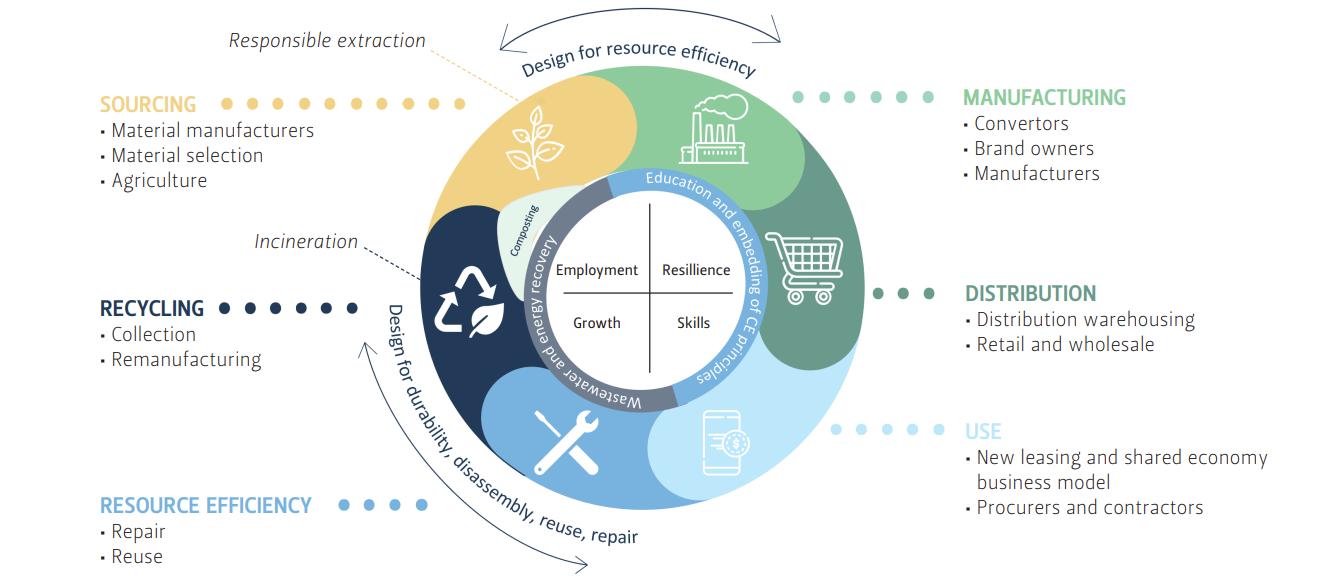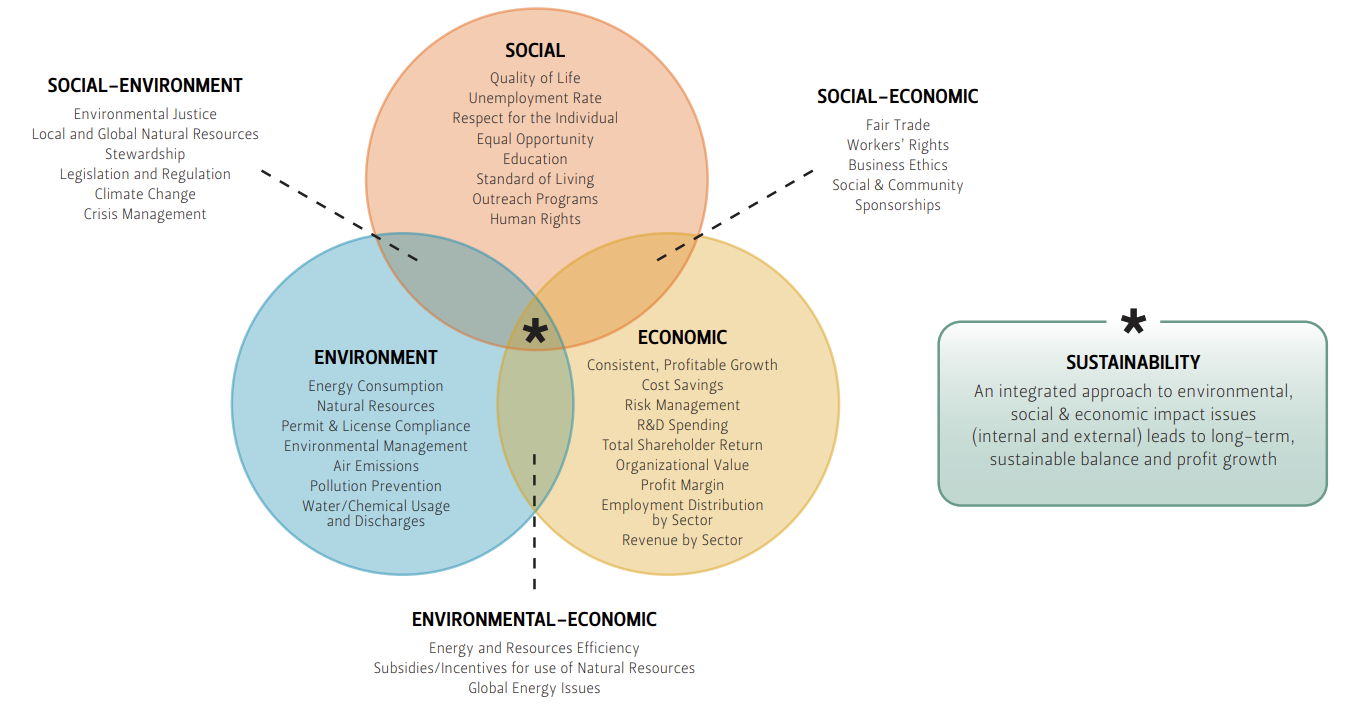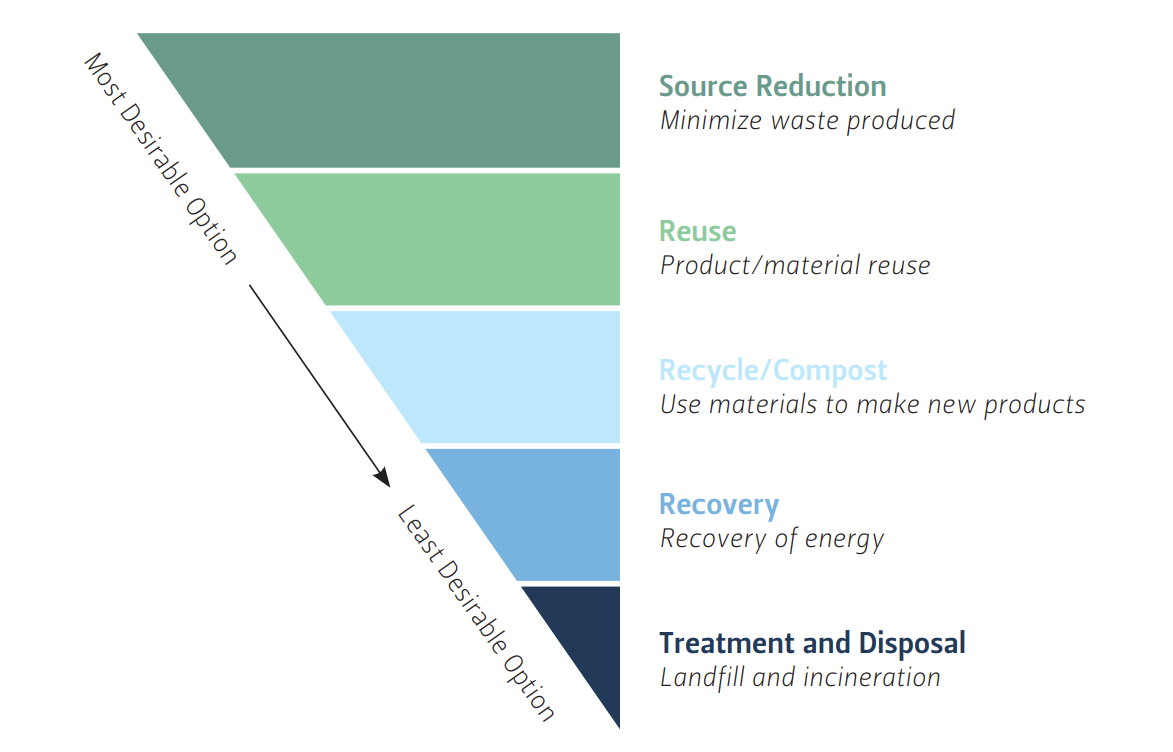Disentangling Circular Economy, Sustainability and Waste Management Principles

Table of Contents
Author(s)
Share this Publication
- Download PDF
- Print This Publication
- Cite This Publication Copy Citation
Meidl, Rachel. 2021. Disentangling Circular Economy, Sustainability, and Waste Management Principles. Issue brief no. 07.29.21. Rice University’s Baker Institute for Public Policy, Houston, Texas.
With the introduction of circular economy (CE) principles in major regions of the world, interest in the concept has increased significantly in the past several years. It is gaining momentum in the political, economic, and scientific fields and growing in popularity in corporate strategies. Local and national governments—including China, Japan, the U.K., France, Germany, Canada, the Netherlands, Sweden, and Finland—are also embracing CE principles. China, ostensibly the global trailblazer in CE, has made circular strategies a part of their national priorities since the early 2000s, recently releasing its 14th Five-Year Plan (2021-25).1 The concept was introduced to the mainstream by the Ellen MacArthur Foundation and is heavily promoted by the European Union. Although the United States does not have a national CE strategy, the framework is trickling into federal and state-level policy discussions and finding its way into many corporate sustainability plans.
The CE (Figure 1) is presumed to have the potential to interrupt the current linear economy of unsustainable production, consumption, and waste generation by encouraging system innovation that designs out waste, increases resource efficiency, keeps materials in use, and decouples growth from the consumption of finite resources—thereby achieving a healthier balance between the economy, the environment, and society.2 The ultimate objective is to transition from today's linear arrangement of “take-make-use-dispose” to a regenerative circular system where the societal value of products, materials, and resources is maximized over time.
Ubiquitously interwoven into the decarbonization, energy transition, and waste minimization narrative is the term “sustainability,” arguably the most misconstrued descriptor of the decade and oftentimes used in conjunction or synonymously with CE. Although there is a relationship between sustainability and a CE, these two concepts are vastly distinct.
Figure 1 — Circular Economy

Sustainability: A Systems-Level Approach
Sustainability in its truest form is a systems-level approach that considers the wide array of environmental, social, and economic factors associated with a process or product and assesses how they interact (Figure 2). It evaluates, as examples, geopolitics, impacts to indigenous communities, sociotechnical capabilities, and other subdomains. The most commonly accepted definition seeks to reconcile economic development with the protection of society and the environment through “development that meets the needs of the present without compromising the ability of future generations to meet their own needs.”3
Sustainability involves quantifying and understanding the risks, trade-offs, and unintended consequences, from a life-cycle perspective, across the entire value chain. This is what leads to long-term system balance. There is very little understanding or application of this in today’s policies and decision-making. Although there is an environmental dimension, sustainability is far more complex than simply focusing on conservation/preservation, choosing presumed eco-friendly options, or switching to alternative energies. A comprehensive understanding of the impact on the overall system and of any potential risk shifting is needed before an action, policy, or product is deemed sustainable.
Theoretically, sustainability is not a property of something. Things in isolation cannot be sustainable (i.e., paper straws, solar panels, electric vehicles, etc.). Sustainability is a feature of a system in its entirety, not a singular focus on any individual part. It embodies how the parts interrelate to enable effective overall outcomes.4 The relationship between a complete system and its environment is what gives rise to large-scale balance and, through this understanding, avoids risk shifting and unintended consequences. From a sustainability perspective, individual parts cannot be optimized without optimizing the whole. For example, an electric vehicle is not sustainable if we factor in the unquantified and unaccounted social and environmental impacts that span the life cycle of the lithium-ion battery that powers the vehicle—from mining, processing, smelting, trade, and transportation across the globally networked supply chain to the lack of recycling and reuse options for the battery at its end of life. The geopolitics and human rights violations involved in such processes, as well as the potential of operating in sensitive environments and collaborating with corrupt regimes that have weak or absent environmental, safety, and labor laws, can also undoubtedly affect a system’s overall sustainability profile.
This scenario is why sustainability imparts such a distorted and complicated challenge to our existing utilitarian structure, because traditionally, we exercise a very systematic and diagnostic method to management and policymaking. We disassemble, dissect, and examine systems into their constituent components, analyze and aggregate the parts, and then attempt to synthesize and optimize, assuming that if all the portions are seemingly functioning, the whole is effective.5 This superficially plausible façade emerges when a limited perspective of sustainability is leveraged, and it ultimately inhibits systems balance.
Figure 2 — Sustainability: A Systems-Level Approach

Although applying a reductionist approach that optimizes individual segments is important in many circumstances (e.g., determining operational and process efficiencies and identifying bottlenecks or redundancies), sustainability—in the absolute sense—involves designing and managing for the whole system.6 In assessing something as complex as an entire economy or global supply chain, it becomes even more critical to understand how the components synchronize and integrate into the whole network. Focusing solely on the individual parts invariably shifts risks elsewhere in the system, thus yielding unsustainable and undesirable outcomes.
How Does a CE Relate to Sustainability?
A CE provides the economic system with an alternative flow model that is cyclical and regenerative by design and builds resilience against future disruptions—like pandemics, extreme and punctuated weather events, or the impacts of a changing climate. Sustainability, mediated by innovation, can enable a CE, and a CE can be a means or stepping stone toward the alignment between the three dimensions of sustainability.7
However, circularity in and of itself does not guarantee positive social, economic, and environmental performance (i.e., sustainability). Just as sustainability can be misrepresented, a CE is accompanied by vast versatility, wide-ranging scope and applications, definitional ambiguities, disparities, and conceptual uncertainties. This makes it challenging to compare with its linear counterparts and can result in a partial, convoluted, or erroneous depiction of circularity—especially since the boundaries and application of a CE can be employed at the product or process level, within an organization, and at the local, regional, national, or global scale for both public and private sectors.
Sustainability of CE strategies should be uniformly and consistently measured against their linear counterparts to identify and avoid actions that are favorable to and increase circularity yet lead to unintended externalities that shift the sustainability profile. For instance, a number of lifecycle assessments demonstrate that some alternatives to plastics perform poorly from an energy and resource standpoint, in areas such as land and water use, energy demand and expenditure, carbon dioxide emissions, waste generation, and global warming and ozone depletion potential.8 While circularity concepts, themes, and frameworks have proliferated, no methods or combination of methods exist that quantify the sustainability impacts of circular strategies.9 Further, to measure the innovations brought by a CE, there is a need to develop multidimensional circularity indicators to measure the CE in its totality.10
After thoughtful consideration of the range of sustainability factors, an institution may decide that a CE agenda may not be the most prudent path forward in the short or medium term, especially if it contravenes the waste management hierarchy and sustainability goals. It is important to understand this relationship and its differentiation. Setting aggressive, simultaneous goals for both circularity and sustainability could be challenging—if not impossible—to achieve, if they are in direct misalignment, or if there are limited means to measure the impacts and no practical strategic or tactical pathways to achieve such goals.
Is a Circular Economy in Conflict With the Waste Hierarchy and Principles of Sustainability?
The traditional waste hierarchy (Figure 3) has been the basis of waste management policy for over 30 years, its genesis culminating from the desire to divert waste from landfills.11 In Europe, it was a response to mounting volumes of waste coupled with a shortage of landfill space, and in the United States, it resulted from the risks of landfilling untreated hazardous waste and the associated environmental and human health concerns.12 The waste hierarchy is a preferential order of waste treatment options with the objective of reducing environmental impacts by prioritizing prevention, reuse, recycling, and recovery over landfill.13
Figure 3 — Waste Management Hierarchy

The hierarchy communicates the relative desirability of waste management options, but a major blind spot is that it does not give any indication regarding trade-offs and the social, environmental, and economic impacts on a local economy. Thus, when viewed from the lens of sustainability, the optimal environmental outcome that is consistent with the hierarchy is not guaranteed. For instance, recycling is costly and can be an energy- and resource-intensive process that yields higher overall impacts across its life cycle than alternative methods. In regions of the world that lack the capability, capacity, technology, and resources for recycling, the preferred sustainable option (and perhaps the lowest carbon option) may be energy recovery or to manage waste in a permitted and secure landfill.
The CE can also be incongruent with how the waste hierarchy has been interpreted and applied. In a CE, the goal is not to manage waste according to the optimal environmental desirability, but to eliminate waste altogether and to keep materials in circulation. Any materials or byproducts that are generated should be managed as raw materials with inherent value, not discarded as waste. An example of CE that conflicts with the hierarchy is the advanced recycling of plastics, a polarizing issue frequently met with skepticism from the public and policymakers. Consistent with the hierarchy, consumers should take measures for waste reduction. Next, if possible, plastics should be reused before recycling, as this has the lowest energy requirement. The subsequent optimal scenario, according to the hierarchy, is recycling until its properties degrade and the material is no longer suitable for mechanical recycling methods, at which point it meets its next hierarchical fate of incineration or landfill.
This is where the principles of the waste hierarchy depart from the principles of a CE. In a circular system, once the polymers no longer have suitable mechanical properties to be taken through additional recycling sequences, they can be chemically converted into their original building blocks and reintegrated into supply chains as feedstocks for new plastics and chemicals, other raw materials for manufacturing, or transportation fuels with a lower environmental footprint, without the need for tapping into virgin materials. This configuration would create a circular polymer economy that “keeps the molecule in play” and prevents advancement to the final phase of the hierarchy—incineration and landfill.
The hierarchy, when originally conceived, did not envision a future scenario that would entail circularity, advanced innovations, or the systems-level thinking of sustainability that challenges the archaic preferential order of waste management. As society has progressed, practitioners and policymakers interpreting and applying the waste hierarchy principles have failed to adapt policies to burgeoning and disruptive technologies that have the ability to create circular, and potentially more sustainable, outcomes than the confines of the hierarchy.
How Do We Establish Connectivity to Ensure System Balance?
Ensuring a successful transition to a sustainable CE requires a common understanding of and approach to circularity; an acknowledgment of circularity’s relationship and contributions to sustainability and long-standing waste management principles; and the ability to consistently measure and report at the microlevel (i.e., a single firm, product, or process) and macroscale (i.e., an entire enterprise; a local, regional, or national government; or even a global system). Incorporating systems-level thinking into new policies and joining forces across the value chain can minimize the impacts of sourcing and extraction and can improve recycling and waste management.
The state of the practice in quantitatively comparing the sustainability impacts of circular systems to their linear counterparts is nascent. Analysis of the applicability and integration of several properly scoped and standardized methods— such as life-cycle assessments, materials flow analysis, systems dynamics, etc.—can provide a more holistic vision that forms the basis for evaluating a range of impacts of a product, material, service, process, or technology. It can also help clarify the relationship and potential conflicts between sustainability, a CE, and waste management principles and provides important tools to identify risks, understand trade-offs, and avoid unintended externalities.
Conclusion
The preparation and conversations should start now about how we can optimize human, capital, and natural resources to create a circular and sustainable economy. When assessed through the lens of systems sustainability, circularity can uncover new investment opportunities, create novel business models, encourage innovative products and technologies, foster supply chain collaboration, and build an economy that is far more resilient against future global disruptions.
Endnotes
1. Ou Yang Shijia, “Circular economy gets 5-year regulator boost,” China Daily, The State Council, The People’s Republic of China, July 8, 2021, http://english.www.gov.cn/policies/policywatch/202107/08/content_ WS60e639b0c6d0df57f98dc92b.html.
2. “Towards the Circular Economy: Economic and Business Rationale for an Accelerated Transition,” Ellen MacArthur Foundation, 2013, https://www. ellenmacarthurfoundation.org/assets/ downloads/publications/Ellen-MacArthur-Foundation-Towards-the-Circular-Economy-vol.1.pdf.
3. Sustainable development was defined by the Brundtland Commission in the 1987 World Commission on Environment and Development’s report, “Our Common Future.”
4. Claudia R. Binder, Romano Wyss, and Emanuele Massaro, eds., Sustainability Assessments of Urban Systems (Cambridge: Cambridge University Press, 2020) https://doi.org/10.1017/9781108574334.
5 Circular Asia Magazine 2021, https://www.circulareconomyasia.org/magazine-2021/.
6. Ibid.
7. Efigênia Rossi et al., “Circular economy indicators for organizations considering sustainability and business models: Plastic, textile and electroelectronic cases,” Journal of Cleaner Production 247 (2020) https://doi.org/10.1016/j.jclepro.2019.119137.
8. N. Voulvoulis et al., “Examining Material Evidence: The Carbon Fingerprint,” Imperial College London, n.d., https://www.imperial.ac.uk/media/imperial-college/faculty-of-natural-sciences/centre-for-environmental-policy/public/veolia-plastic-whitepaper.pdf.
9. Julien Walzberg et al., “Do We Need a New Sustainability Assessment Method for the Circular Economy? A Critical Literature Review,” Frontiers in Sustainability 1, 12 (January 2021) https://doi.org/10.3389/frsus.2020.620047.
10. Rossi et al., “Circular economy indicators.”
11. W. Van Ewijk and J.A. Stegemann, “Limitations of the waste hierarchy for achieving absolute reductions in material throughput,” Journal of Cleaner Production 132 (2016): 122-128, https://doi.org/10.1016/j.jclepro.2014.11.051.
12. Ibid.
13. Ibid.
This material may be quoted or reproduced without prior permission, provided appropriate credit is given to the author and Rice University’s Baker Institute for Public Policy. The views expressed herein are those of the individual author(s), and do not necessarily represent the views of Rice University’s Baker Institute for Public Policy.



